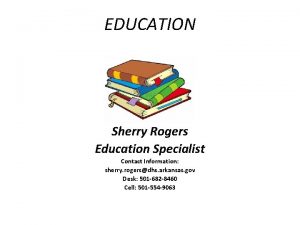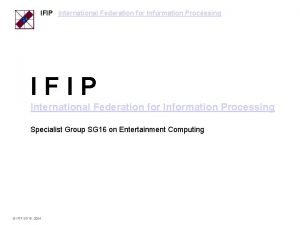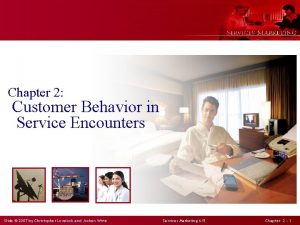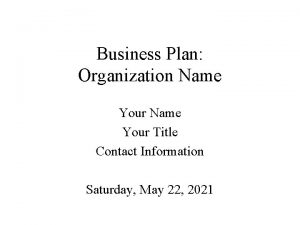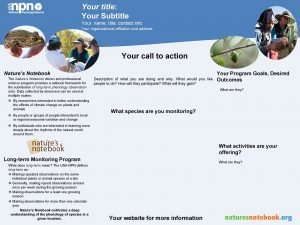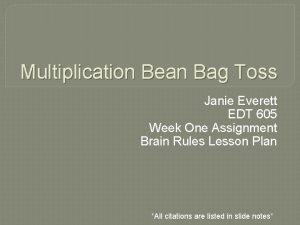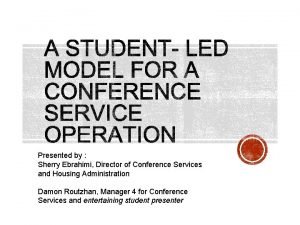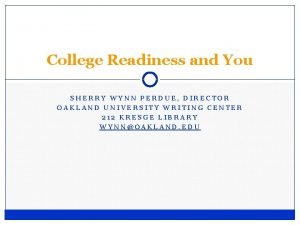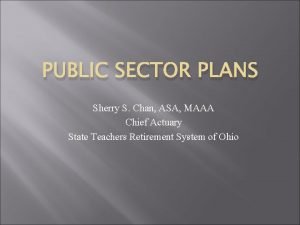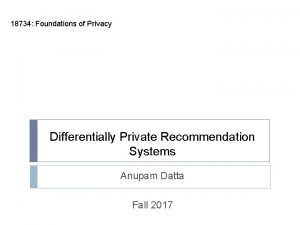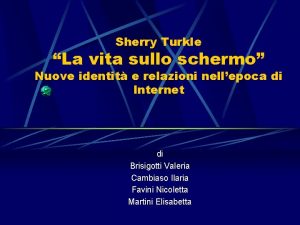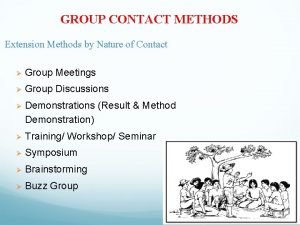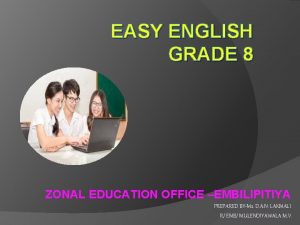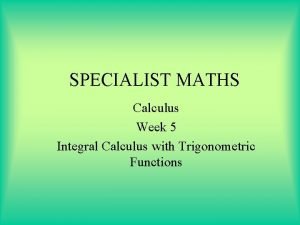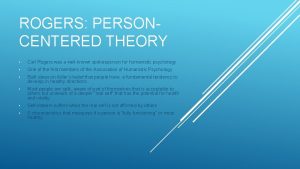EDUCATION Sherry Rogers Education Specialist Contact Information sherry





































- Slides: 37

EDUCATION Sherry Rogers Education Specialist Contact Information: sherry. rogers@dhs. arkansas. gov Desk: 501 -682 -8460 Cell: 501 -554 -9063

Agenda Statistics - - If not us, then who will be their advocates? Mc. Kinney-Vento to Title I Part D and Foster Care Laws Academic and Behavior Supports Difference between Section 504 and Special Education and how/when to place a student Discipline protocol for Regular and Special Education Students Dispute Resolution Process Resources Available

Educational Outcomes for kids in Foster Care National research (Casey Family Programs) shows that children in foster care at high-risk of dropping out of school and are unlikely to attend or graduate from college. 37% do not finish high school and 1. 8% complete a bachelors degree Use the GED to complete education at 6 times the rate of general population • • host of barriers that lead to troubling outcomes, including low academic achievement, grade retention and lower high school graduation rates Foster kids face steep challenges to school success, including high rates of mobility. Student overall GPA drops 1% with each school change; Most experience 7 or more school changes • Kids in foster care need advocates to inspire, support, and guide them to pursue post secondary college and career opportunities and training

If not us…then who will be their advocates? to improve the educational outcomes for children in foster care Who will take the lead? to make educational decisions that are in THE FOSTER CHILD’S best interest? COMMON SENSE PRACTICES: Ø Attending Parent / Teacher Conferences Ø Eschool Plus - Monitor grades and attendance. Make sure the school is being notified of absences; give them copy of appointment document Ø Tutoring – check with school staff for after school tutoring, extra reading interventions during the school day, reading recovery, summer or ESL programs before suggesting that we pay for outside tutoring. Make sure the school is implementing interventions and supports. Ø Play an active roll and be an active participant in the IEP and SBIT/RTI meetings.

From Mc. Kinney Vento to ESSA- Title I Part A Effective December 10, 2017 The new protections for children in foster care under ESSA will apply to all children in foster care enrolled in public schools. builds upon a new focus in ESSA on the unique needs of foster youth Focus continues to be to ensuring educational stability for children in foster care and Postsecondary Education and Training The child is to remain in their school of origin unless determination is made that it is not in their best interest Requires Increased collaboration between the LEA’s and the Child Welfare Agency as it relates to: – Best interest determination-is staying in the school of origin is in the child’s best interest? – Transportation

Focus of Foster Care Laws Under Every Student Succeeds Act 1. Increase educational stability 2. Emphasize importance of collaboration between educational and child welfare agencies to ensure students have same opportunity to achieve at high levels

School of Origin (ESSA) School of origin: the school in which a student is enrolled at the time of placement in foster care. Note: Student can remain in their school of origin or attend school in the district in which they reside.

Best Interest Determination (ESSA) Some students will need transportation to remain in their school of origin. However, transportation costs should not be considered when determining a child’s best interest.

Best Interest Determination Factors that the child welfare and educational agencies should consider: ü ü ü ü Preferences of child Child’s attachment to the school Placement of siblings Influence of school climate on child Availability of services to meet needs History of school transfers How length of commute would impact student Some students will need transportation to remain in their school of origin. However, transportation costs should not be considered when determining a child’s best interest.

Transportation (ESSA) LEAs should collaborate with state and local child welfare agencies to provide transportation and maintain foster care students in their school of origin, when in their best interest for the duration of the child’s time in foster care

Transportation Costs The LEA may use Title I funds to pay for additional costs to transport children in foster care to their school of origin. If there additional costs incurred in providing transportation, the LEA will provide such transportation if: • The child welfare agency agrees to reimburse the LEA for the cost; • The LEA agrees to pay for the cost; OR • The LEA and local child welfare agency agree to share the cost

Academic Supports and Behavior Supports

• Tutoring -Can a private tutor be hired and will DHS assist in paying for private learning centers, if needed? Check with school staff for tutoring, extra reading tutoring during the school day, reading recovery, summer or ESL programs before suggesting that we pay for outside tutoring. Make sure the school is implementing supports • Parent Teacher/School Staff Conferences • Involve the LEA Foster Care Liaison • Make sure student is placed under Sp. Ed or 504, if necessary • Make sure the IEP or 504 Plan is implemented correctly; ask to meet with the IEP Team, look closely at the goals and progress made toward those goals; Extended Year Program; be an advocate • Utilize all school supports: Ask the school about academic support, before and after school tutoring, Reading Recovery Program, Read 180, Accelerated Reader, STAR Reading and other literacy supports, double blocked classes, Academic improvement Plan

RESPONSE TO INTERVENTION ( RTI ) (academic and behavior interventions) Response to Intervention (RTI) is a multicomponent, general education model, designed to identify students who may be at risk for learning or behavior challenges, offer support, and monitor progress

What RTI Is. . . and What It Is Not… RTI Is… • A preventive system of support • A framework to provide a • continuum of services for all students • A program focused on effective instruction to enhance student growth • A system to provide instructional intervention immediately upon student need

RTI Is Not… A single program Just about interventions A pre-referral system for special education An individual teacher, classroom, or class period • An out-of-the-classroom service • •

RTI: Arkansas model Multi-Tiered System of Support Data-based Decision Making Screening/Diagnostics/Progress Monitoring Formative/Summative Assessment


Special Education and Section 504 What is the difference?


IEP 504 What is it? ABILITY to learn ACCESS to learning What does it do? Provides individualized education and related services to the child Provides services and changes to learning environment to meet needs of the child AS ADEQUATELY as other students What law? IDEA *Fed spec ed law for children with disabilities Section 504 of the Rehab Act of 1973 *Fed civil rights law to stop discrimination against people with disabilities Who uses it? • Child meets requirement for one or more of the 13 specific disability categories listed in IDEA. {learning and attention issues may qualify} • Child has mental or physical impairment which limits one or more major life activities • Has a record of such impairment or • Is regarded as having such an impairment • Parent generally makes initial referral for Special Education/504 evaluation but it can be anyone concerned about the student’s educational needs. • WRITE a “Request for Testing/Placement” letter to Special Education director; Copy others.

Section 504 Anything that substantially limits a child’s ACCESS to his/her education. Qualifying handicaps are not as severe as the disabilities qualifying a student for an IEP/Special Education. The student may need extra help to access learning through accommodations that are put into place. Categories of Impairment: - Has a physical or mental impairment which substantially limits a life activity (learning) - Has a record of such impairment - Is regarded as having such impairment Examples of disabilities qualifying a student for 504 accommodations: Asthmatic, Diabetics Obese students (if have underlying med. cond. ) ADD(HD) Temporary disabled (broken leg, arm, etc. ) Epilepsy Illness that causes attendance problems THERE ARE EXTRA LAYERS OF PROTECTIONS A SCHOOL MUST PUT INTO PLACE BEFORE DISCIPLINARY SANCTIONS FOR CHILD UNDER 504.

Process to get a child placed under 504 • Make a written request to the school and referral conference held. • Evaluation for 504 does NOT necessarily mean testing. The 504 coordinator gathers information from a variety of sources so the committee can make a determination w/ in 60 days. Sources: grades, disciplinary referrals, health information, language surveys, parent information, standardized test scores, teacher comments & recommendations, attendance records, observation • Placement Conference is held (including parent) and supportive accommodation plan is put in place w/ in 30 days of evaluation

SPECIAL EDUCATION Applies to students with a severe impairment/disability who qualify for Special Education Services in the (LRE) Least Restrictive Environment possible. The child’s DISABILITY affects his/her ABILITY to learn. Categories of Impairments listed under Special Education: Autism Speech or Language (communication disorder) Dyslexia Emotional Disturbance (severe social deficit) Orthopaedic Hearing Impairment Visual Impairment Traumatic Brain Injury Multiple Disabilities (Hearing & vision) Other Health Impairment (ex. severe ADHD, health problem) Mental Retardation Developmental Delay (ex. comm. , motor, social emotional) Specific Learning Disability (severe discrepancy btw intellectual ability and achievement) Individualized Education Program (IEP) is a written plan based on the child’s individual needs that testing reflects. The team develops the IEP to put modifications/supports in place for the child to be successful in the regular education classroom. The Team develops the IEP within 30 days after qualified. A Behavior Intervention/Support Plan is developed for students with behavior issues in addition to the IEP. The IEP may also include specialized transportation services for if not safe or possible for the child to ride a bus provided for the general population


Process to get a child placed under Special Education: • Submit a request in writing to the school for the child to be considered for special education to the Sp. Ed Director and the building principal. Keep a copy • Within 60 calendar days the school must complete testing. • Within 30 days after the testing, the staff must place the child in Special Education and implement the child’s IEP. • From the date of the written request the district has a total of 90 CALENDAR DAYS to have placed the student in Special Edu. and implement the Individualized Education Plan.

Sample Letter-Request for Testing/Placement under Special Education Today’s Date (include month, day, and year) Your Name Street Address City, State, Zip Code Your email address Daytime telephone number Name of Principal Name of School Street Address City, State, Zip Code Re: Child’s Name, Name of School, Purpose of the Letter (Request for Meeting) Dear (Principal’s name), My name is (name) and my child, (child’s name), is a student in the (__) grade in (name of teacher)’s class at (name of school). (You may want to add something positive here about your child’s situation before you state your reason for writing. ) I am writing because (give a brief explanation. Give relevant history and facts that support your concerns. For example, your third grader is struggling in school and you want to ask for help. You might say that your child’s schoolwork has been getting worse throughout the year. That fact is relevant. Something from your child’s infancy probably isn’t. ) To address this situation, I would like the school to (state what you would like to have happen or what you would like to see changed. You may briefly say what you would not like, or what has been tried and not worked. However, spend most of this paragraph saying what you want. ) (Say what type of response you would prefer. For instance, do you need to meet with someone, do you want a return letter or email, or will a phone call be preferable? ) My daytime number is (give your phone number). I look forward to hearing from you. I would appreciate a response by (give a date one or two weeks from the letter). Thank you for your attention to this matter. Sincerely, Your name cc / copy sent to: your child’s Principal, Counselor, Teacher, Sp. Ed District Dir. , LEA Foster Care Liaison, and DCFS Edu. Liaison

What is Special Education and 504? ? Youtube. com/watch? V=9 Dkt. V 772 nj. Y

What if My Student is Being Disciplined for Breaking School Rules? Ø • • Expect documentation concerning the incident: written statements written suspension notice, meeting or hearing notice, date of the Manifestation Determination Review (Special Education) Ø Parents have the right to appeal the school’s decision to a higher level Ø Reference the school district discipline policy for category for the offence and sanction related Ø Expect the school/teacher/SBIT to have put interventions in place for the child dealing with behavior or academic issues to be successful: Response To Intervention (RTI) Ask the administration if this has been initiated!!! As part of RTI - The School Based Intervention Team (SBIT) will assist with recommendations for interventions for the child who needs more intensive interventions than other children. Documentation should be available!

Kids who are covered under Special Education Services: Interventions for Behavior Actions (Interventions) the school implements: • Behavior Support Specialists – Conduct the FBA. All districts have access to BSS within districts or through the Education Cooperative Service. • Functional Behavior Assessment –Data collection through classroom observation • The Behavior Support Plan is best if it is developed with data compiled from the FBA.

Behavior Support/Modification Plan The student’s Behavior Plan should include: ü ü Targeted Behaviors for change Positive strategies Programs or curricular modifications Supplementary aids and supports to address the behaviors of concern with more positive behaviors Emphasis placed on skills(replacement behaviors) needed by the student to behave in a more appropriate manor and provide proper motivation

Discipline Guidelines for Students With Disabilities School personnel may remove a child with a disability from class if they violate a code of student conduct. Students may not be suspended beyond a total of 10 school days for the year without an MDR. Upon the 10 th day of suspension - the IEP Team must hold an MDR : Manifestation Determination Review Conference is held: • to determine if the child was in the appropriate placement. • to determine if there is a connection between the child’s behavior and their disability / diagnosis. • If the child’s disability had an influence on their behavior- the suspension is stopped and the IEP team determines when student returns to school and the consequences. The Behavior Support Plan is updated at this time by the IEP team. If there is no connection between the disability and the behavior the IEP team makes the recommendation the suspension must be struck or modified. The IEP team also includes the FSW/Foster Parent or Surrogate. If the school is placing the student that is in Sp. Ed in In School Suspension-Special Education Services must continue.

Behavior Support Specialists – Through the district or Ar Services Cooperatives or larger districts may have their own. Circuit Referral - complete online https: //arksped. k 12. ar. us/applications/Circuit/Request. aspx Through the AR Dept of Education Special Education Dept. The Circuit Team is a regional group of special education consultants who can assist in identification and interventions needed for students with sensory, intellectual and disabilities, multiple physical disabilities, and /or self-injurious behavior, and autism spectrum disorders. CIRCUIT Services can be requested by parents, guardians, or district school administrators (i. e. , special education supervisors, principals, and superintendents).

What If You Don’t Agree With The Schools Decision? • Dispute Resolution Process: Internal appeal to Principal, Sp. Ed Director and Superintendent • Mediation Process – Bowen School of Law – 501 -324 -9939 ualr. edu/law/clinical-programs/mediation/ • If the school does not act upon the request, appeal to the next level ; complete the Request for Student Referral – “CIRCUIT” https: //arksped. k 12. ar. us/applications/Circuit/Request. aspx • File a written complaint w/ Ar Dept of Special Education – 501 -682 -4221 Mail to: ADE Special Education Unit 1401 West Capitol Ave. Victory Bldg. Suite 450 Little Rock, AR 72201 • School District Special Education yearly Survey – rate the LEA’s Special Education services https: //arksped. k 12. ar. us/Applications/Surveys/

RESOURCES: School District Foster Care Liaison (LEA Point of Contact) LEA Liaison contact information – found in CHRIS; client education screen when adding/updating education information – found on ADE website -contacts -districts http: //www. arkansased. gov/ LEA Liaison is responsible to help with: - Enrolling in school - Transportation issues - Obtaining shot or medical records - Coordinate efforts for referrals to health, mental health, dental, and other support services - Referral for educational services: ESL, Vocational, GT, remediation, school nutrition, Head Start/Preschool Programs; tutoring programs - Speak to your foster parents about rights of their children in foster care and the parent’s opportunities for involvement State Law requires notification to the school the foster child is enrolled and attending school there (CFS-384 -LEA)

Resources School District Foster Care Liaison LEA Liaison contact information – found in CHRIS; client education screen – found on ADE website- contacts- districts http: //www. arkansased. gov/ The Center for Exceptional Families/ AR PTI • Consultation • Conduct trainings on Special education/504 • Advocate with parent at IEP meetings • Shelby. Knight@tcfef. org Executive Director in Jonesboro (888)360 -9654 • Tracy. Risley@tcfef. org North West AR (501)897 -4174 • Loreena. Hegenbart@tcfef. org North Central AR (870)897 -4175 • Denise. Ennett@tcfef. org Central Arkansas (501) 612 -2008 • Teresa. Dodson@tcfef. org South West AR (501)398 -1667 • Lakesha. Whitman@tcfef. org South East AR (870) 897 -4173 Assoc. Director • Cinthia. Castro@tcfef. org Multicultural Specialist statewide (501)398 -1646 DCFS Education Liaison- Sherry Rogers cell: 501 -554 -9063 wk: 501 -682 -8460

 Sherry rogers
Sherry rogers Information processing specialist
Information processing specialist Contact and non contact force examples
Contact and non contact force examples Which of the following is sliding contact bearing
Which of the following is sliding contact bearing Contact vs non contact forces
Contact vs non contact forces Two objects sliding past each other experience
Two objects sliding past each other experience Dermatitis atopica icd 10
Dermatitis atopica icd 10 Contact vs noncontact forces
Contact vs noncontact forces Ohmic contact
Ohmic contact Difference between high contact and low contact services
Difference between high contact and low contact services Force and motion
Force and motion Air resistance contact force
Air resistance contact force Contact information title
Contact information title Title contact information
Title contact information Janie bean contact information
Janie bean contact information Sherry ebrahimi
Sherry ebrahimi Sherry wynn
Sherry wynn Sherry chan actuary
Sherry chan actuary 3 ts ng pakikilahok at bolunterismo
3 ts ng pakikilahok at bolunterismo Tammy homolka
Tammy homolka Cheri stephenson
Cheri stephenson What is hegemonic masculinity
What is hegemonic masculinity A copita is a glass designed for this fortified wine
A copita is a glass designed for this fortified wine Sherry hamby
Sherry hamby Sherry towers
Sherry towers Alone together book
Alone together book Sherry
Sherry Jill hornor
Jill hornor Vijaya sherry chand
Vijaya sherry chand Sherry velasco usc
Sherry velasco usc Fargevalør
Fargevalør Sherry turkle la vita sullo schermo
Sherry turkle la vita sullo schermo Sherry rohekar
Sherry rohekar It is an example of group method in extension
It is an example of group method in extension Zonal education office embilipitiya contact number
Zonal education office embilipitiya contact number Non specialist audience
Non specialist audience Formula sheet specialist
Formula sheet specialist Punto rojo seo
Punto rojo seo
